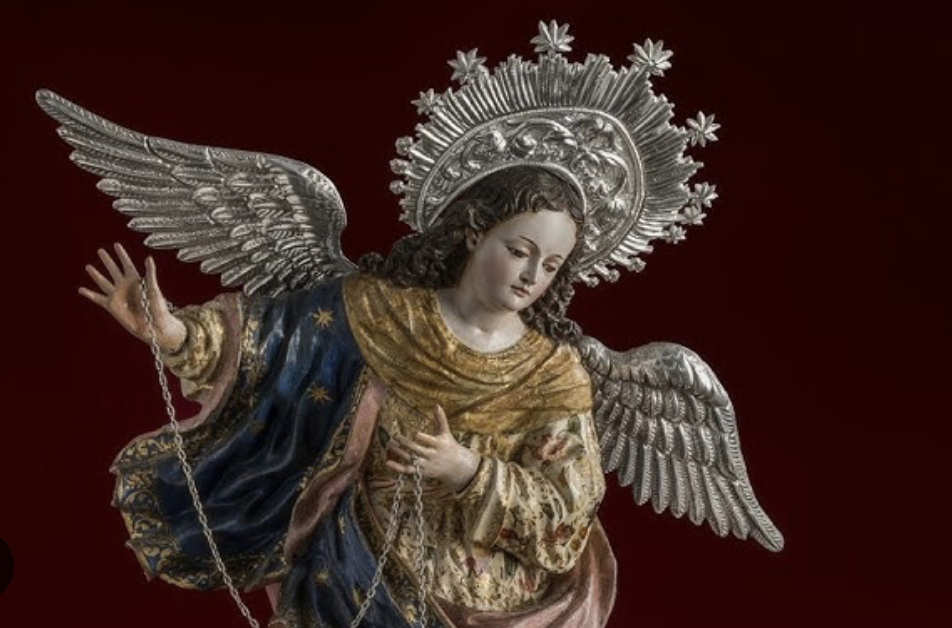[Op-Ed] The Escuela Quiteña: A Gilded Act of Resistance

MORE IN THIS SECTION

La Compañía Church, Quito's Baroque Materipiece. Credits to Casa Gangotena
Step into the Church of La Compañía de Jesús in Quito, and you are swallowed whole by gold. The baroque interior glows under layers of pan de oro (gold leaf), covering every column, arch, and altar with an almost divine radiance. But step outside, and the façade tells a different story—one carved in volcanic stone, adorned with Indigenous symbols, a silent but powerful nod to the people who built this masterpiece. This is the Escuela Quiteña, the Quito School of art, a movement that was both an act of devotion and a quiet rebellion, where two cultures—Spanish Catholicism and Indigenous Andean traditions—collided, intertwined, and created something neither had seen before. A colonial masterpiece that never fully surrendered to its makers.
The Art of Conversion
The Escuela Quiteña, which flourished from the 17th to 18th centuries, was not just an artistic movement—it was a strategy. Introduced by Franciscan friars, it sought to convert Indigenous and Mestizo populations through art that would dazzle and overwhelm. It worked.
Quito’s artists mastered the Spanish baroque style, but they pushed it further. They perfected polychromy, layering pigments to give sculptures unnervingly lifelike skin. Glass eyes reflected light with eerie realism, egg-yolk varnish made paintings glow, and figures were sculpted with individual hands—a detail that allowed for more expressive, human gestures.
And then, of course, there was the gold. Nowhere else in the Americas was pan de oro applied with such extravagance. The message was clear: step inside a Quito church, and you weren’t just walking into a place of worship—you were stepping into heaven itself.
But there was more at play here than just religious devotion. Because while these works looked European, they were not.
A Hidden Defiance
Forced to paint and sculpt Catholic imagery, Indigenous and Mestizo artists found ways to reclaim the narrative. The saints and virgins they created had Andean features—high cheekbones, dark eyes, full lips. The Holy Spirit, typically depicted as a dove in European art, appeared as a condor—the sacred bird of the Andes.
Even in the grandest churches, resistance was carved into the stone. La Compañía’s intricate façade—designed to draw Indigenous worshippers inside—is full of Andean motifs. What better way to lure the local population into Christianity than by using their own symbols?
This was the paradox of the Escuela Quiteña: it was both an instrument of colonization and a canvas for defiance. A forced artistic tradition that, over time, became something uniquely Ecuadorian.

Sculpture of the Virgin of Quito, based on the work of Bernardo de Legarda. Credits to Goraymi.
A Lost Masterpiece
By the 19th century, the Escuela Quiteña began to fade. Ecuador’s independence, political shifts, and changing artistic tastes pushed aside the baroque excess in favor of neoclassical simplicity. Many masterpieces were lost, stolen, or simply left to decay.
RELATED CONTENT
But not all was lost.
Today, if you want to see the true survival of the Quito School, don’t just visit museums or colonial churches—go to San Antonio de Ibarra. There, artisans still carve wood with the same precision and devotion, still apply gold leaf by hand, still shape pewter, wood and glass using techniques passed down through generations.
The Escuela Quiteña never truly disappeared—it just moved into the hands of the people.
The Legacy of Gold and Stone
La Escuela Quiteña is more than an art movement—it’s a testament to perseverance. It proves that art can be used to manipulate, to convert, to impose power. But it also proves that art can resist, absorb, and transform that power into something new.
And unlike European traditions, where paintings and sculptures were meticulously copied, the Escuela Quiteña had no true reproductions—only references. No piece is the same. Each work is an original, touched by the hands of its creator, shaped by their personal technique, their interpretation, their quiet defiance.
So the next time you stand beneath the golden domes of La Compañía, look deeper. Look at the hands that carved these saints, the shiny varnished faces of the sculptures and the frames of the paintings. The Escuela Quiteña is not just a relic of the past—it is an art style that has endured the test of time and worth admiring in craft and story.
The Quito School flourished between the 16th and 18th centuries in the Real Audiencia of Quito, marking a significant artistic period. Notable figures such as Diego de Robles, Miguel de Santiago, Nicolás Javier Goribar, Bernardo de Legarda, Manuel Chili "Caspicara," and Manuel de Samaniego, among others, left behind a diverse legacy of works. Paintings, sculptures, and architectural structures from this school are still preserved and can be admired in museums and churches throughout the city of Quito.





LEAVE A COMMENT: